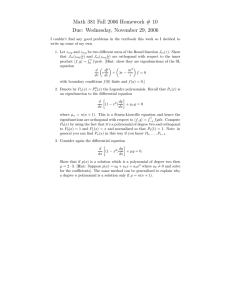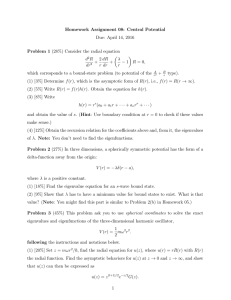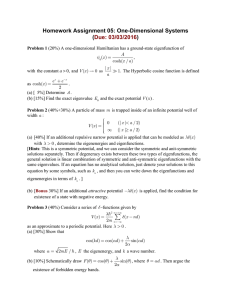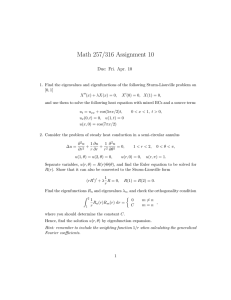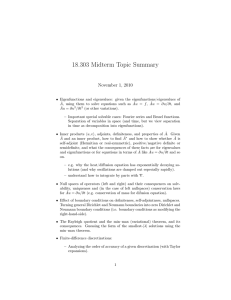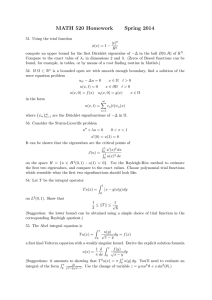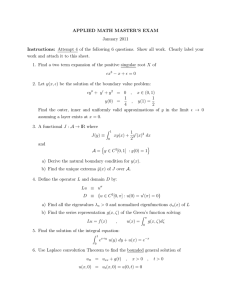Lecture #12: Looking Backward Before First Hour Exam
advertisement
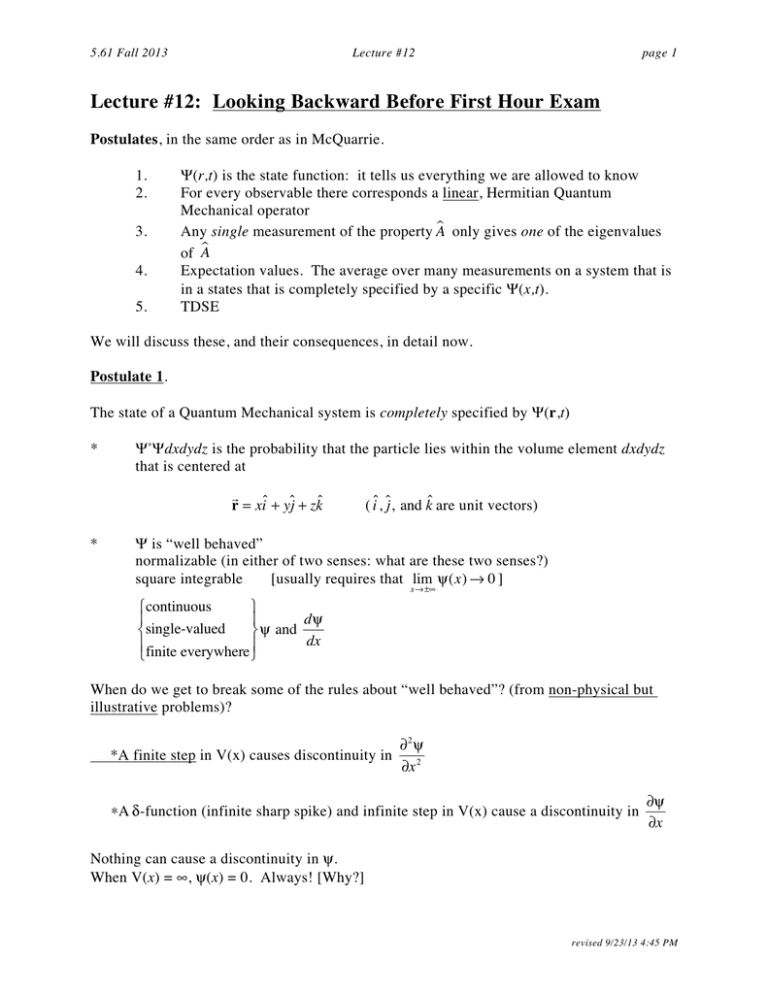
5.61 Fall 2013
Lecture #12 page 1
Lecture #12: Looking Backward Before First Hour Exam
Postulates, in the same order as in McQuarrie.
1. 2. 3.
4. 5.
Ψ(r,t) is the state function: it tells us everything we are allowed to know
For every observable there corresponds a linear, Hermitian Quantum
Mechanical operator
/ only gives one of the eigenvalues
Any single measurement of the property A
/
of A
Expectation values. The average over many measurements on a system that is
in a states that is completely specified by a specific Ψ(x,t).
TDSE
We will discuss these, and their consequences, in detail now.
Postulate 1.
The state of a Quantum Mechanical system is completely specified by Ψ(r,t)
*
Ψ∗Ψdxdydz is the probability that the particle lies within the volume element dxdydz
that is centered at
r = xiˆ + yĵ + zk̂
*
( iˆ, ĵ, and k̂ are unit vectors)
Ψ is “well behaved”
normalizable (in either of two senses: what are these two senses?)
square integrable
[usually requires that lim ψ(x) → 0 ]
x→ ±∞
⎧continuous
⎫
dψ
⎪
⎪
⎨single-valued
⎬ ψ and
dx
⎪finite everywhere ⎪
⎩
⎭
When do we get to break some of the rules about “well behaved”? (from non-physical but
illustrative problems)?
*A finite step in V(x) causes discontinuity in
∂2 ψ
∂x 2
∗Α δ-function (infinite sharp spike) and infinite step in V(x) cause a discontinuity in
∂ψ
∂x
Nothing can cause a discontinuity in ψ.
When V(x) = ∞, ψ(x) = 0. Always! [Why?]
revised 9/23/13 4:45 PM
5.61 Fall 2013
Lecture #12
page 2
Postulate 2
For every observable quantity in Classical Mechanics there corresponds a linear, Hermitian
Operator in Quantum Mechanics.
/ (c ψ + c ψ ) = c A
/
/
linear means A
1 1
2 2
1 ψ 1 + c2 Aψ 2 . We have already discussed this.
Hermitian is a property that ensures that every observation results in a real number (not
imaginary, not complex)
A Hermitian operator satisfies
∞
∞
ˆ )dx =
∫ f (Ag
∫ g(Â * f *)dx
= ( A ) (useful short-hand notation)
*
−∞
A fg
−∞
*
gf
where f and g are well-behaved functions. This provides a very useful prescription for how to “operate to the left”. Suppose we replace g by f to see how Hermiticity ensures that any measurement of an observable quantity must be real. ∫
∞
−∞
/ fdx =
f *A
∫
∞
−∞
/ * f * dx from the definition of Hermitian
fA
Aff = (Aff)*
/ in state f.
/ f , the expectation value of A
The LHS is just A
The RHS is just LHS*, which means
LHS = LHS*
/
thus A
f
is real.
Non-Lecture Often, to construct a Hermitian operator from a non-Hermitian operator, Ânon-Hermitian , we take (
)
/ QM = 1 A
/ non-Hermitian + A
/*
.
A
non-Hermitian
2
/=A
/B
/ is constructed out of non-commuting factors, e.g. OR, when an operator C
revised 9/23/13 4:45 PM
5.61 Fall 2013
Lecture #12
page 3
/, B
/ ⎤⎦ ≠ 0 . ⎡⎣ A
/ Hermitian = 1 ( / / / / ) .
Then we might try C
AB + BA
2
Angular Momentum
Classically
⎛ iˆ
= r̂ × p̂ = ⎜⎜ x
iˆ + ĵ + k̂ ⎜
⎝ px
x
x
= ypz – zpy
y
z
ĵ
y
py
k̂ ⎞
⎟
z⎟
pz ⎟⎠
Does order matter?
[ y, p ] = 0 ⎞
z
⎟ by inspection (of what?)
⎡⎣ z, py ⎤⎦ = 0 ⎠
which is a good thing because the standard way for compensating for non-commutation,
r̂ × p̂ + p̂ × r̂ = 0
fails, so we would not be able to guarantee Hermiticity this way
End of Non-Lecture
Postulate 3
/ gives one of the eigenvalues
Each measurement of the observable quantity associated with A
/.
of A
/ψ = a ψ
A
n
n n
/
the set of all eigenvalues, {an } , is called spectrum of A
Measurements:
a1,ψ1
ψ
/
A
a2,ψ2
etc.
revised 9/23/13 4:45 PM
5.61 Fall 2013
Lecture #12
page 4
Measurement causes an arbitrary ψ to “collapse” into one of the eigenstates of the
measurement operator.
Postulate 4
/ is / ≡ ∞ ψ * A
/ψdτ .
For a system in any state normalized to 1, ψ, the average value of A
A ∫−∞
(dτ means integrate over all coordinates).
We can combine postulates 3 and 4 to get some very useful results.
1.
Completeness (with respect to each operator)
ψ = ∑ ci ψ i
expand ψ in a “complete basis set” of eigenfunctions, ψi
i
(many choices of “basis sets”)
/ {ψ } , {a }
Most convenient to use all eigenstates of A
i
i
A
ˆ
We often use a complete set of eigenstates of A {ψ n
} as “basis states” for the operator Bˆ
even when the {ψ A
} are not eigenstates of Bˆ .
n
2.
Orthogonality
If ψi,ψj belong to ai ≠ aj, then ∫ dxψ *i ψ j = 0 . Even when we have a degenerate eigenvalue, where ai = aj, we can construct orthogonal functions. For example: /ψ = a ψ , A
/ψ = a ψ , ψ ,ψ are normalized but not necessarily orthogonal. A
1
2
1
1 1
2
1 2
NON-Lecture
Construct a pair of normalized and orthogonal functions starting from ψ1 and ψ2.
Schmidt orthogonalization
S ≡ ∫ dxψ1* ψ 2 ≠ 0, the overlap integral
ψ′2 = N ( ψ 2 + aψ1 ), constructed to be orthogonal to ψ1
∫ dxψ1* ψ′2 = N ∫ dxψ1* ( ψ 2 + aψ1 )
= N ( S + a ).
If we set a = –S, ψ′2 is orthogonal to ψ1. We must normalize ψ′2.
revised 9/23/13 4:45 PM
5.61 Fall 2013 Lecture #12
page 5
1 = ∫ dxψ 2′* ψ 2′ = N 2 ∫ dx ( ψ *2 − S * ψ 1* ) ( ψ 2 − Sψ 1 )
= N 2 ⎡⎣1 − 2 S 2 + S 2 ⎤⎦
−1/2
N = ⎡⎣1 − S 2 ⎦
⎤
ψ 2′ = ⎡⎣1 − S 2 ⎤⎦
−1/2
( ψ 2 − Sψ1 )
ψ′2 is normalized to 1 and orthogonal to ψ1. This turns out to be a very useful trick.
“Complete orthonormal basis sets”
Next we want to compute the {ci} and the {Pi}. Pi is the probability that an experiment on ψ
yields the ith eigenvalue.
ψ = ∑ ci ψ i
i
(ψ is any normalized state)
Left multiply and integrate by ψ *j (which is the complex conjugate of the eigenstate of Â
that belongs to eigenvalue aj).
∫ dxψ *j ψ = ∫ dxψ *j ∑ ci ψ i
i
= ∑ ci δ ji
i
c j = ∫ dxψ *j ψ (so we can compute all {ci })
What about
/ = ∑ Pi ai
A
i
⎤
/ψ = ∫ dx ⎡ c*ψ * ⎤ A
/⎡
∫ dxψ * A
⎢∑ i i ⎥ ⎢∑ c j ψ j ⎥
⎣ i
⎦ ⎣ j
⎦
⎤
⎤⎡
⎡
= ∫ dx ⎢ ∑ ci*ψ *i ⎥ ⎢ ∑ a j c j ψ j ⎥
⎣ i
⎦⎣ j
⎦
Orthonormality kills all terms
in the sum over j except j = i.
revised 9/23/13 4:45 PM
5.61 Fall 2013
Lecture #12 page 6
2
/ψ =
∫ dxψ * A
∑ ci ai
i
/ = ∑ ci 2 ai
thus A
i
2
Pi = ci = ∫ dxψ *i ψ
2
so the “mixing coefficients” in ψ
ψ = ∑ ciψi
become “fractional probabilities” in the results of repeated measurements of A.
 = ∑ Pi ai
2
Pi = ∫ dxψ *i ψ .
/, B
/ ⎤⎦ commutator tell us about
What does the ⎡⎣ A
* the possibility for simultaneous eigenfunctions
* σAσB ?
1.
/ are eigenfunctions of B
/
/, B
/ ⎦⎤ = 0 , then all non-degenerate eigenfunctions of A
If ⎣⎡ A
(see page 10).
2.
/, B
/ ⎤⎦ = const ≠ 0
If ⎡⎣ A
σ 2A σ 2B ≥ −
2
1
∫ dxψ * [ A, B ] ψ ) > 0 (and real)
(
4
nnote that [ x̂, p̂ ] = in
this gives
σ px σ x ≥
n
(see page 11)
2
NON-LECTURE
Suppose 2 operators commute
/ B
/ ⎤⎦ = 0
⎡⎣ A,
revised 9/23/13 4:45 PM
5.61 Fall 2013
Lecture #12 page 7
/.
Consider the set of wavefunctions {ψi} that are eigenfunctions of observable quantity A
/ψ = a ψ
A
i
i i
{ai } are real
/, B
/ ⎤⎦ ψ i = ∫ dxψ *j ( A
/B
/−B
/A
/ )ψi
0 = ∫ dxψ *j ⎡⎣ A
commutator is 0
/B
/ψ − ∫ dxψ * B
/A
/ψ
= ∫ dxψ *j A
j
i
i
/ψ − a ∫ dxψ * B
/
= a j ∫ dxψ *j B
i
i
j ψi
/ψ
= ( a j − ai ) ∫ dxψ *j B
i
/ψ
0 = ( a j − ai ) ∫ dxψ j B
i
I
i
B ji
if aj ≠ ai → Bji = 0
this implies that ψi and ψj are eigenfunctions of B̂ that belong to
different eigenvalues of Bˆ
if aj = ai → Bji ≠ 0
This implies that we can construct mutually orthogonal
eigenfunctions of B̂ from the set of degenerate eigenfunctions of
 .
/ are eigenfunctions of B
/ and eigenfunctions of B
/
All nondegenerate eigenfunctions of A
/.
can be constructed out of degenerate eigenfunctions of A
Some important topics:
0.
1. 2.
3. 4. 5. 6. 0.
Completeness.
For a Hermitian Operator, all non-degenerate eigenfunctions are orthogonal and the
non-degenerate ones can be made to be orthonormal.
S
chmidt orthogonalization
/ eigenfunctions of B
/ if ⎡ A
/ ⎤⎦ = 0 ?
Are eigenfunctions of A
⎣ /, B
/, B
/ ⎤⎦ ≠ 0 ⇒ uncertainty principle free of any thought experiments.
⎡⎣ A
∂
Why do we define p̂ as − in ?
∂x
Express non-eigenstate as linear combination of eigenstates.
Completeness. Any arbitrary ψ can be expressed as a linear combination of functions
that are members of a “complete basis set.”
revised 9/23/13 4:45 PM
5.61 Fall 2013
Lecture #12
page 8
For a particle in box
⎛ 2⎞
ψn = ⎜ ⎟
⎝ a⎠
1/2
⎛ nπ ⎞
sin ⎜
x
⎝ a ⎟⎠
h2
En = n
8ma 2
2
complete set n = 1, 2, … ∞ What do we call these ψn in a non-QM context?
ψ = ∑ ci ψ i ,
ci = ∫ dxψ *i ψ
i
To obtain the set of {ci}, left-multiply ψ by Ψ*i and integrate. Exploit orthonormality of the
basis set {ψi}.
Fourier series: any arbitrary, well-behaved function, defined on a finite interval (0,a), can be
decomposed into orthonormal Fourier components.
∞
1
nπx
nπx ⎞
⎛
f (x) = a0 + ∑ ⎜ an cos
+ bn sin
⎟.
⎝
2
a
a ⎠
n=1
For our usual ψ(0) = ψ(a) = 0 boundary conditions, all of the an = 0. We can use particle in
box functions {ψn} to express any ψ where ψ(0) = ψ(a) = 0. Another kind of boundary
condition is periodic (e.g. particle on a ring) ψ(x + a) = ψ(x) where a is the circumference of
the ring. Then, for the 0 ≤ x ≤ a interval, we need both sine and cosine Fourier series.
1.
Hermitian Operator
/ is Hermitian, all of the non-degenerate eigenstates of A
/ are orthogonal and all of the
If A
degenerate ones can be made orthogonal.
/ is Hermitian
If A
revised 9/23/13 4:45 PM
5.61 Fall 2013
Lecture #12
�
A j=
dxψi∗ Aψ
����
aj ψ j
�
page 9
A∗ ψ ∗
dxψj A
� �� �i
ai∗ ψi∗
/
/
A
a∗i = ai because A
corresponds to a
classically
observable quantity
rearrange
(a
j
− ai ) ∫ dx ψ *i ψ j = 0
I i
order of these
doesn't matter
either aj = ai (degenerate eigenvalue)
OR
when aj ≠ ai ψi is orthogonal to ψj.
Now, when ψi and ψj belong to a degenerate eigenvalue, they can be made to be orthogonal,
/.
yet remain eigenfunctions of A
⎞
⎛
⎞
/⎛
A
⎜⎝ ∑ ci ψ i ⎟⎠ = a j ⎜⎝ ∑ ci ψ i ⎟⎠
i
i
for any linear combination of degenerate eigenfunctions.
Find the correct linear combination. Easy to get a computer to find these orthogonalized
functions.
Non-Lecture 2.
Schmidt orthogonalization
We can construct a set of mutually orthogonal functions out of a set of non-orthogonal
degenerate eigenfunctions.
revised 9/23/13 4:45 PM
5.61 Fall 2013
Lecture #12
page 10
Consider two-fold degenerate eigenvalue a1 with non-orthogonal eigenfunctions, ψ11 and ψ12.
Construct a new pair of orthogonal eigenfunctions that belong to eigenvalue a1 of Aˆ .
*
overlap S11,12 = ∫ ψ 11
ψ 12
ψ′11 ≡ ψ 11
ψ 12
′ ≡ N [ ψ 12 − S11,12 ψ 11 ]
Check for orthogonality:
*
*
∫ dxψ 11
′*ψ 12
′ = N ⎡⎣ ∫ dxψ 11
ψ 12 − S11,12 ∫ dxψ 11
ψ 11 ⎤⎦
= N [ S11,12 − S11,12 ] = 0.
Find normalization constant:
1 = ∫ dxψ′12* ψ′12
2
*
*
⎤
⎡ ∫ dxψ 12
ψ 12 + S11,12 ∫ dxψ 11
ψ 11
⎥
= N ⎢
*
*
*
⎢⎣
− ∫ dxψ 12
S11,12 ψ 11 − ∫ dxS11,12
ψ 11
ψ 12 ⎥⎦
2
2
2
2
= N 2 ⎡⎣1 + S11,12 − S11,12 − S11,12 ⎦⎤
2
= N 2 ⎡⎣1 − S11,12 ⎦⎤
2
N = ⎡⎣1 − S11,12 ⎦⎤
−1/2
2
ψ′12 = ⎣⎡1 − S11,12 ⎤⎦
−1/2
[ψ
12
− S11,12 ψ 11 ]
Now we have a complete set of orthonormal eigenfunctions of Aˆ . Extremely convenient and
useful.
End of Non-Lecture
3.
/ also eigenfunctions of B
/ if ⎡ A
/ ⎤⎦ = 0 ?
Are eigenfunctions of A
⎣ /, B
/B
/=B
/ A
/
A
/ B
/ A
/ψ = B
/ψ = ai B
/ψ
A
i
i
i
(
)
(
)
(
)
/ belonging to eigenvalue a . If a is non-degenerate,
/ψ is eigenfunction of A
thus B
i
i
i
/
/
Bψ i = cψ i , thus ψi is also an eigenfunction of B .
revised 9/23/13 4:45 PM
5.61 Fall 2013
Lecture #12
page 11
/ and
We can arrange for one set of functions {ψi} to be simultaneously eigenfunctions of A
/ when ⎡ A
/ ⎤⎦ = 0 .
B
⎣ /, B
This is very convenient. For example: nx, ny, nz for 3D box and eigenvalues of J?2 and J/z
for rigid rotor. Another example: 1D box has non-degenerate eigenvalues. Thus every
eigenstate of Ĥ is an eigenstate of a symmetry operator that commutes with Ĥ .
4.
/, B
/ ⎤⎦ ≠ 0 ⇒ uncertainty principle free of any thought expt.
⎡⎣ A
Suppose 2 operators do not commute
/ ≠ 0.
/ B
/ ⎦⎤ = C
⎡⎣ A,
It is possible (we will not do it) to prove, for any Quantum Mechanical state ψ
σ 2A σ 2B ≥ −
(
1
/ψ
∫ dxψ * C
4
)
2
≥ 0.
Consider a specific example:
/ = x̂
A
/ = p̂
B
x
revised 9/23/13 4:45 PM
5.61 Fall 2013
Lecture #12
page 12
[ x̂, p̂x ] f (x) = x̂p̂x f − p̂x xfˆ
∂
∂
f − ( −in ) (xf )
∂x
∂x
= ( −in )[ xf ′ − f − xf ′ ]
= x ( −in )
= +inf
∴
[ x̂, p̂x ] = +in Il
⇓
unit
operator
so the above (unproved) theorem says
1 ⎡in ∫ dxψ * ψ ⎤ 2
n2
σ σ ≥−
=
−(−1)
Ii ⎥
⎦
4 ⎢⎣
4
=1
n
Heisenberg uncertainty principle
σ xσ p ≥ +
2
2
x
2
px
This is better than a thought experiment because it comes from the mathematical properties
of operators rather than being based on how good one’s imagination is in defining an
experiment to measure x and px simultaneously.
Non-Lecture
5.
Why do we define p̂ as p̂ = −in
∂
?
∂x
Is the -i needed? Why not +i?
∞
p̂ = −in ∫ dxψ *
−∞
d
ψ
dx
which must be real, p̂ = p̂ * . But is it?
revised 9/23/13 4:45 PM
5.61 Fall 2013
Lecture #12
page 13
integrate by parts,
treat ψ* and ψ as
linearly independent
functions
∞
p = +in ∫ dxψ
*
−∞
d
dψ
∞
⎤
ψ* = +(in) ⎢⎡ ψψ * −∞ − ∫ dx
ψ *⎥ = p
dx
⎣
dx
⎦
took complex
conjugate of the
equation for p
0
because ψ,ψ* must
go to zero at ± ∞
thus p = p *, i is needed in p̂ .
i vs. –i is an arbitrary phase choice, supported by a physical argument.
Suppose we have
ψ = eikx
p̂ψ = −in ( ik ) e
ikx = +nkeikx
we like to associate p̂ with +nk rather than –nk.
6.
Suppose we have a non-eigenstate ψ for the particle in a box
for example,
ψ(x) = Nx(x − a) (x − a/2)
{z �} �| ��
{z }�
�| ��
0..
•..................
a
•
......
.......
.......
.......
.......
......
......
......
.
.
.
.
.
.
.....
..
....
.....
....
....
.... ......
... ...
... ..
.....
=
....................................
.......
.....
.....
....
...
....
.
.
.
....
....
....
...
.
.
... ..
...
...
.
...
...
...
..
.
...
.
...
.
.
.
...
.
....
....
....
....
....
....
....
...
.
.
.
.
......
......
.......
.......
...........
..........................
•
•
poor man’s
ψ2
Normalize this revised 9/23/13 4:45 PM
5.61 Fall 2013
Lecture #12
∫
a
0
page 14
a
dx ψ * ψ = 1 = N 2 ∫ dx x 2 ( x − a )2 ( x − a / 2 )2
0
⎛ 840 ⎞
find that N = ⎜ 7 ⎟
⎝ a ⎠
1/2
.
⎛ 2⎞
Now expand this function in the ψ n = ⎜ ⎟
⎝ a⎠
1/2
sin
nπx
basis set.
a
∞
ψ = ∑ cn ψ n
n =1
find the cn
Left multiply by ψ *m and integrate
∞
∫ dxψ ψ = ∑ cn ∫ dx ψ *m ψ n = cm
n =1
*
m
orthogonal
cm = ( 840 ) a
1/2
−7 /2
⎛ 2⎞
⎜⎝ ⎟⎠
a
1/2
a
x − a )( x − a / 2) sin
∫0 dx x (
odd with respect to
0,a interval
mπx
a
needs to be
odd on 0,a
too in order
to have an
even
integrand
thus cm = 0 for all odd-m
m = 2n – 1
n = 1,2, … c2n–1 = 0 c2n ≠ 0 find them revised 9/23/13 4:45 PM
5.61 Fall 2013
Lecture #12
c2n =
(1680 )1/2
a4
2nπx
change variables y =
a
16801/2
=
a4
steps skipped
c2n = 16801/2
page 15
2nπx
⎛ 3 3 2 a2 ⎞
dx
∫0 ⎝⎜ x − 2 ax + 2 x ⎟⎠ sin a
a
∫
2nπ
0
⎡ a ⎞ 3 3 3 ⎛ a ⎞ 2 2 a2 ⎛ a ⎞ ⎤ ⎛ a ⎞
dy ⎢⎜⎛
⎟ sin y
⎟ y − a ⎝⎜
⎟ y + ⎝⎜
⎟ y⎥ ⎜
2 2nπ ⎠
2 2nπ ⎠ ⎦ ⎝ 2nπ ⎠
⎣⎝ 2nπ ⎠
6
= 0.9914 n
−3
3
(2nπ)
c2 ≈ 1 as expected from general shape of ψ.
∞
/ψ =
Now that we have {cn}, we can compute E = ∫ dx ψ * H
∑ Pn En
n =1
prob­
ability
Pn = cn2
∞
2
E = ∑ E2n c2n = E1 ∑ ( 2n ) [ 0.9914n −3 ]
2
n =1
2
n =1
∞
= 4E1 ( 0.983) ∑ n −4 ≈ 4E1
n =1
(Is this a surprise for a
function constructed to
resemble ψ2 where E2 =
4E1?)
End of Non-Lecture
revised 9/23/13 4:45 PM
MIT OpenCourseWare
http://ocw.mit.edu
5.61 Physical Chemistry
Fall 2013
For information about citing these materials or our Terms of Use, visit: http://ocw.mit.edu/terms.
